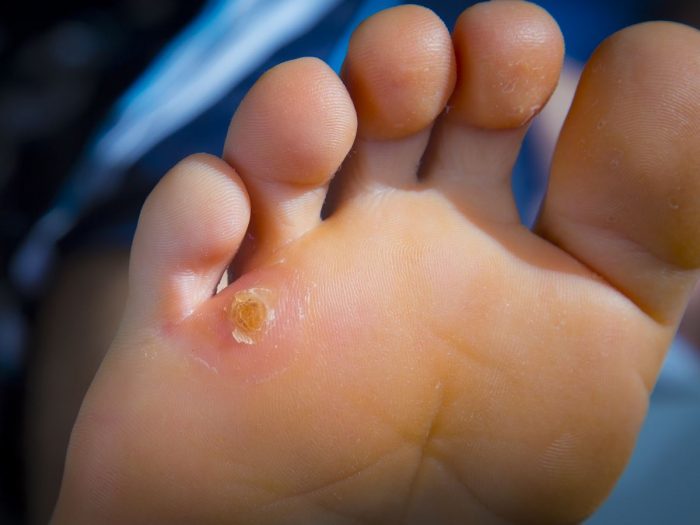One of the most persistent and annoying conditions affecting the feet are corns and calluses, and these things can affect millions of people each year. It is essential that you understand the ways to prevent them from developing in the future, as well as effective remedies.
Corns and calluses develop due to excessive friction or pressure on the skin of the palms of our hands and soles of our feet. This causes the skin to become hard and thick. Though, it is important to note that corns and calluses are not the same. [1]
- Corns develop on the feet, are smaller than calluses, they may be painful, and usually have a hard center.
- Calluses are found on the feet and hands, are larger in size, and generally not painful.
Home Remedies for Corns and Calluses
There are various natural remedies that are effective in providing relief from corns and calluses.
Lemon
When you are suffering from a painful corn, most of that discomfort is coming from the hard center of the corn, which is constantly pressed on, causing even more inflammation. Lemon juice, however, is packed with antioxidants and natural soothing agents that can soften the hardened skin. Eventually, the hard center of the corn will fall out, relieving the pain. [2]
Onion
Onions are packed with nutrients and powerful acids that can neutralize infections and stimulate the immune system, but onion juice can also smooth hardened skin and cause the dead skin to flake off. In the case of a corn or callus, you can apply an onion directly to the affected site and cover it with a bandage. Within 1-2 days, this should cause the callus to soften and fall off. [3]

Corns and calluses often develop on the feet and toes or hands and fingers. Photo Credit: Shutterstock
Castor Oil
If you are suffering from a case of corns or calluses, one of the best remedies you can turn to is castor oil. This old-time remedy for skin conditions of all kinds can effectively soften the callus or corn when mixed with hot, soapy water. Applying a pumice stone to the corn or callus following a hot water soak with castor oil can quickly and painlessly reduce the callus. [4]
Vitamin E
When it comes to natural antioxidants that can improve the health of our skin in countless ways, vitamin E may be your best bet. You can directly apply concentrated vitamin E by emptying a gel capsule, or you can simply increase the amount of vitamin E that you intake in your body. This will help to boost the health of the skin and eliminate dead skin. Vitamin E-rich foods include sunflower seeds, hazelnuts, broccoli, and squash. [5]
Baking Soda
This powerful natural remedy is particularly good for exfoliating the skin and ensuring that healthy, oxygenated skin is protected. You can soak your feet in baking soda mixed with warm water, and this will soften the calluses. After helping the skin be sloughed off, baking soda will also help protect the exposed skin from fungal or bacterial infections, which can be common following the removal of calluses and corns.
Garlic
As one of the best antioxidant substances that we know of, garlic remains an important remedy for so many health conditions, including corns and calluses. Garlic’s powerful acids and organic compounds, particularly allicin, will help to improve the health of the feet and eliminate inflammation. Garlic is also antibacterial in nature, so it will protect the feet and toes from infections as well. [6]
Massage
By massaging any part of the body, it can induce the flow of blood to that area of the body. Rich, oxygenated blood can help to shed dead skin cells by pushing fresh, healthy skin cells to the surface. Massaging can also soften the hardened skin covering the callus, making it easier to slough and remove. [7]
Licorice
While many people only think of licorice as a type of sweet, it actually plays an important part in many aspects of human health. For the treatment of corns and calluses, a paste can be made by mixing licorice powder with ground mustard seed and water. This paste should be applied directly to the corns and calluses. The rich blend of antioxidants and other healing compounds found in licorice can speed the sloughing process of the dead skin and can push out the hard center of the corn. [8]
Papaya
This rather incredible fruit can deliver all sorts of important health benefits for those who regularly consume it, but it can also be a topical application for corns and calluses. Simply extract the juice from a papaya and apply it gently to the site of the calluses and corns. This will help the dead skin fall off, and also dry up the area of the skin, due to its astringent properties, speeding up the healing process. [9]
Aspirin
Most people associate aspirin with headaches and pain, but it is also an effective blood-pressure reducer, commonly known as a blood-thinner. This can improve the flow of blood to extremities, like the hands and feet, where corns and calluses are more common. Using aspirin in moderation can help new skin cells develop, causing dead layers of skin to fall off. [10]
Epsom Salts
While this isn’t the fastest remedy, it is one of the most effective. Pouring Epsom salts into a bath of hot water, soak your calluses or corns for 10-15 minutes. The blend of minerals and organic compounds in Epsom salts will help soften the hardened surface of the foot and make it much easier to use a file to gradually wear down the callus. Do this slowly, however, as you do not want to dig too deeply into the foot, which opens you up to infections and other complications. [11]
